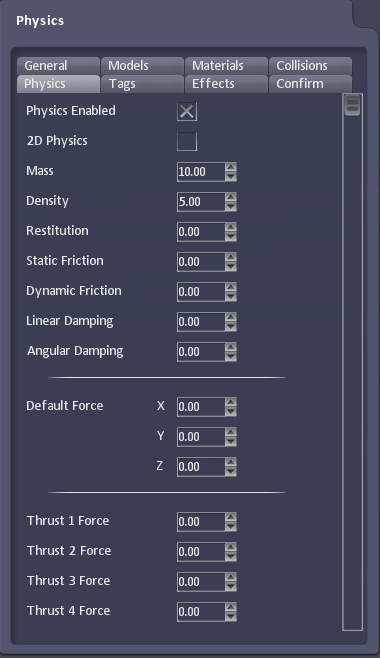Difference between revisions of "Physics Tab"
From Shoot Em Up Kit
(Created page with "The Physics tab contains information on the physical properties of the Entity. These include the Mass, Density and Friction. It is also possible to add some default forces a...") |
|||
| Line 11: | Line 11: | ||
| − | {| | + | {|class="wikitable" |
|style="vertical-align:top;width:160px;|'''Physics Enabled''' | |style="vertical-align:top;width:160px;|'''Physics Enabled''' | ||
|Setting the Physics Enabled property will specify whether the Entity uses physics or not. If Physics is enabled the forces such as gravity will be applied to the Entity and collisions will be more realistic. Not using physics is more efficient and can make the Entity more predictable and controllable. | |Setting the Physics Enabled property will specify whether the Entity uses physics or not. If Physics is enabled the forces such as gravity will be applied to the Entity and collisions will be more realistic. Not using physics is more efficient and can make the Entity more predictable and controllable. | ||
Latest revision as of 15:47, 24 May 2020
The Physics tab contains information on the physical properties of the Entity. These include the Mass, Density and Friction. It is also possible to add some default forces and set the forces of the thrusters.
To edit Physics properties go to the Physics tab for the entity - this is accessed by selecting an entity in the Entity Editor.
There is also a Simple Physics option that can be set by checking the box in Project Settings. This gives a basic physics simulation that is more efficient than the full physics system but more limited.

| Physics Enabled | Setting the Physics Enabled property will specify whether the Entity uses physics or not. If Physics is enabled the forces such as gravity will be applied to the Entity and collisions will be more realistic. Not using physics is more efficient and can make the Entity more predictable and controllable. |
| 2D Physics | If using physics then you can constrain the physical effects to a 2D plane. This will prevent items from moving out of their 2D axis if a collision occurs, for example |
| Mass | The Mass of the Entity is related to its weight. It affects how much force is required to move the object. |
| Density | The Density property refers to the weight in relation to its volume. |
| Restitution | The Restitution property affects the stability of the Entity and how long it takes an object to settle after falling. |
| Static Friction | The Static Friction property affects the amount of force required to get an object moving from idle. |
| Dynamic Friction | The Dynamic Friction property affects the amount of force required to keep an object moving once it is already in motion. |
| Linear Damping | The Linear Damping property affects the speed in which an object will stop moving. |
| Angular Damping | The Angular Damping property affects the speed in which an object will stop spinning. |
| Default Force | The amount of force which is constantly applied to the Entity. This can be used to counteract the force of gravity and allow the Entity to float, for example, or push the Entity through the level. |
| Thrust 1 (to 5) Force | The Thrust 1 Force property specifies how much force will be applied at the Thrust 1 tag when the user presses the Thrust 1 button on their controller. |